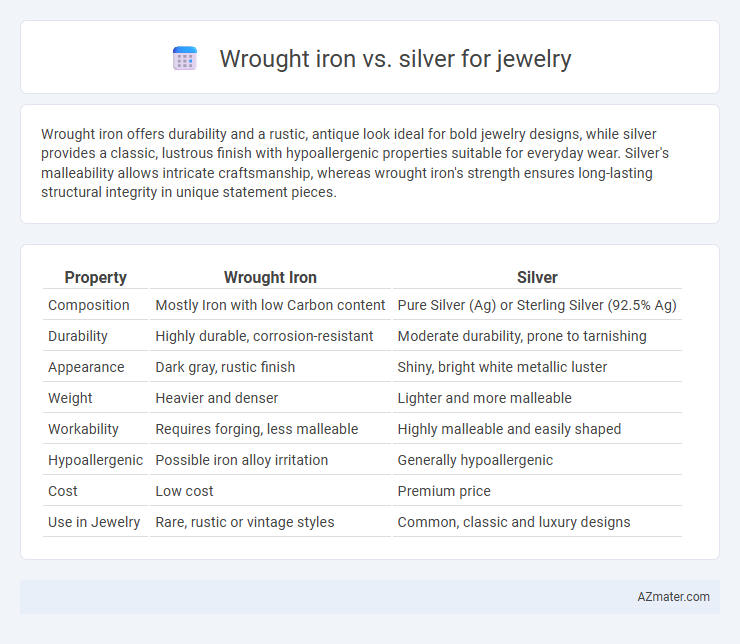Wrought iron offers durability and a rustic, antique look ideal for bold jewelry designs, while silver provides a classic, lustrous finish with hypoallergenic properties suitable for everyday wear. Silver's malleability allows intricate craftsmanship, whereas wrought iron's strength ensures long-lasting structural integrity in unique statement pieces.
Table of Comparison
| Property | Wrought Iron | Silver |
|---|---|---|
| Composition | Mostly Iron with low Carbon content | Pure Silver (Ag) or Sterling Silver (92.5% Ag) |
| Durability | Highly durable, corrosion-resistant | Moderate durability, prone to tarnishing |
| Appearance | Dark gray, rustic finish | Shiny, bright white metallic luster |
| Weight | Heavier and denser | Lighter and more malleable |
| Workability | Requires forging, less malleable | Highly malleable and easily shaped |
| Hypoallergenic | Possible iron alloy irritation | Generally hypoallergenic |
| Cost | Low cost | Premium price |
| Use in Jewelry | Rare, rustic or vintage styles | Common, classic and luxury designs |
Introduction to Wrought Iron and Silver in Jewelry
Wrought iron is known for its durability and rustic charm, often used in jewelry to create bold, handcrafted designs with a vintage appeal. Silver, a precious metal prized for its lustrous shine and hypoallergenic properties, remains a popular choice for fine jewelry due to its versatility and elegant appearance. Both materials offer unique aesthetic qualities, with wrought iron providing a rugged texture and silver delivering a polished, classic finish.
Historical Significance of Wrought Iron and Silver Jewelry
Wrought iron jewelry has a rich historical significance, symbolizing strength and resilience in ancient cultures, often used in medieval armor and ornamental designs. Silver jewelry, prized for its luster and rarity, has been associated with wealth and spiritual protection across civilizations from the Egyptians to Native Americans. Both metals carry deep cultural meanings, with wrought iron representing durability and craftsmanship, while silver embodies elegance and sacred value.
Composition and Properties of Wrought Iron
Wrought iron, composed primarily of iron with a low carbon content (typically less than 0.08%) and trace amounts of slag, offers exceptional malleability and corrosion resistance due to its fibrous structure. Unlike silver, which is a precious metal known for its high conductivity and bright luster, wrought iron is valued for its toughness and durability, making it suitable for rustic and vintage jewelry designs. Its ability to withstand mechanical stress and develop a unique patina distinguishes wrought iron from the softer, more reactive nature of silver in jewelry applications.
Composition and Properties of Silver
Silver, primarily composed of 92.5% pure silver and 7.5% other metals such as copper in sterling silver, offers excellent malleability and a naturally bright, reflective luster that enhances jewelry aesthetics. Unlike wrought iron, which is mainly iron with very low carbon content and prone to rust, silver resists corrosion and tarnishing with proper care, making it ideal for long-lasting, finely detailed designs. Its hypoallergenic nature and high electrical conductivity further distinguish silver as a superior choice for sensitive skin and intricate craftsmanship in jewelry.
Durability and Strength Comparison
Wrought iron jewelry offers exceptional durability and strength due to its dense, fibrous composition that resists bending and breaking under stress. Silver, while prized for its lustrous appearance and malleability, is softer and more susceptible to scratches and dents, especially in its pure form or sterling grades. For long-lasting pieces that can withstand daily wear and tear, wrought iron presents a sturdier option compared to silver's delicate nature.
Aesthetic Appeal: Visual Differences
Wrought iron jewelry features a dark, rustic finish with intricate, handcrafted patterns that emphasize durability and vintage charm, contrasting sharply with silver's bright, polished luster and smooth surface that exude elegance and modernity. Silver's reflective quality enhances fine details and adds a timeless, sophisticated shine, while wrought iron's matte texture creates a bold, industrial aesthetic that appeals to alternative fashion styles. The visual difference between the two metals lies in wrought iron's robust, artisanal appearance versus silver's sleek, classic brilliance, making each suitable for distinct aesthetic preferences in jewelry design.
Hypoallergenic Qualities of Wrought Iron vs Silver
Wrought iron is less commonly used in jewelry due to its potential to cause skin irritation or allergic reactions because it contains iron alloys that may oxidize and irritate sensitive skin. Silver, particularly sterling silver (92.5% pure silver mixed with copper), is generally considered hypoallergenic and is a preferred metal for those with metal sensitivities, although some individuals may react to the copper alloy. For hypoallergenic jewelry, high-purity silver or alternatives like titanium and surgical stainless steel are recommended over wrought iron to minimize allergic responses.
Maintenance and Care Requirements
Wrought iron jewelry requires regular cleaning to prevent rust and corrosion, often needing protective coatings or oils to maintain its appearance. Silver jewelry demands consistent polishing to avoid tarnish and should be stored in anti-tarnish bags or cloths to preserve its shine. Both metals benefit from avoiding exposure to moisture, chemicals, and harsh environments to extend their longevity and maintain aesthetic appeal.
Cost and Value Considerations
Wrought iron jewelry is significantly more affordable than silver, making it an attractive option for budget-conscious buyers seeking unique, rustic designs. Silver offers higher intrinsic value due to its precious metal status, enhancing its resale potential and longevity as an investment piece. While wrought iron lacks the market demand and durability of silver, it provides distinctive artistic appeal at a fraction of the cost.
Best Applications: Choosing the Right Metal for Jewelry
Wrought iron, known for its durability and rustic appeal, is ideal for bold, statement jewelry pieces such as bracelets and rings that require a strong metal with a unique texture. Silver, prized for its bright luster, hypoallergenic properties, and ease of engraving, is best suited for intricate designs, delicate chains, and everyday wear accessories. Selecting the right metal depends on the desired aesthetic, durability needs, and skin sensitivity considerations, with wrought iron excelling in robust, artisanal creations and silver preferred for elegant, classic designs.

Infographic: Wrought iron vs Silver for Jewelry
 azmater.com
azmater.com